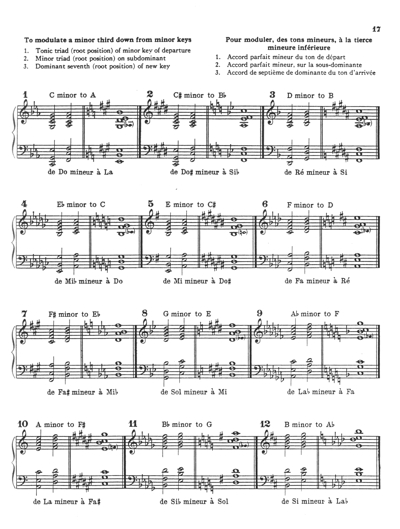 |
The Art Of Modulating Carlos Salzedo & Lucile Lawrence |
|
| Contents: | Theory / Technique - See contents below | |
| Instrumentation: | Harp, piano or organ | |
| Level: | Intermediate to Advanced | |
| Format: | 304 X 228 stapled score | |
| ISMN: | 978-0-7935-5232-0 | |
| Publisher: | G. Schirmer, Inc. | |
| Series: | -- | |
| Edition/Year: | 1950 | |
| Origin: | USA | |
| Our Ref: | UM1028 | |
Buy this music now £11.95 +p&p |
||
| Other music by Carlos Salzedo | ||
| Other music by Lucile Lawrence | ||
The Art Of Modulating
Carlos Salzedo & Lucile Lawrence
Including Modulating Formulas, Examples of Modulations, Extensions, Cadenzas, and a complete illustration of Harmonic Fluxes (Glissandi) followed by Ten Fragments of Dances and Five Easy Characteristic Pieces for Harp.
INTRODUCTION
This treatise has been made as simple and concise as the subject permits. It was primarily intended for the excusive use of harpists but was found adaptable to the needs of organists and pianists. The modulating formulas given herein are by no means the only ones that can be used, but they have been selected in preference to others because they are short and harmonically correct—therefore, practical. These formulas consist of not more than three chords: 1) the tonic triad (root position) of the key of the composition just ended; 2) a transitory chord; 3) the dominant seventh (root position) of the key of the composition that follows. In some instances only two chords are necessary: 1) the tonic triad (root position) of the key of the composition just ended; 2) the dominant seventh (root position) of the key of the composition that follows.
This book, having been prepared mainly for the use of instrumentalists with but a slight knowledge of harmony, ninth chords, suspensions, and other elaborate harmonic devices have not been used in these formulas. As the instrumentalist acquires a feeling for modulating, he should abandon the exclusive use of the triad chord so as to adorn the modulation with richer harmonies. This, however, must not be attempted prematurely, because it might bring too much abruptness or strangeness into the modulation.
One will find a few examples of modulating improvisations; but inasmuch as the art of modulating implies the art of improvising, it goes without saying that the modulating improvisations should be left to the skill and imagination of the instrumentalist.
